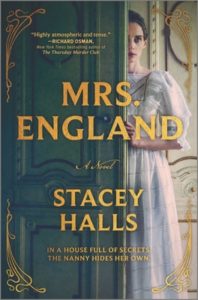 If a publisher is going to send an anglophile like myself a book titled “Mrs. England,” well, I’m going to read it. I was not disappointed, and I was instantly immersed in the story of Norland nanny Ruby May, a 1904 graduate of the now famous school (the nannies trained there are hired by royal families today). In 1904 the school was new, and the idea of any training or learning about childcare was a novelty, as were the distinctive uniforms the Norland nannies wore (and still wear to this day.)
If a publisher is going to send an anglophile like myself a book titled “Mrs. England,” well, I’m going to read it. I was not disappointed, and I was instantly immersed in the story of Norland nanny Ruby May, a 1904 graduate of the now famous school (the nannies trained there are hired by royal families today). In 1904 the school was new, and the idea of any training or learning about childcare was a novelty, as were the distinctive uniforms the Norland nannies wore (and still wear to this day.)
As the book opens, Ruby is happily employed but when her boss informs her the family is moving from London to someplace called Chicago, she declines to accompany them, citing family reasons, and is forced to find another post. She ends up heading north to Yorkshire to work for the family of a wool mill owner. The family has four children – a change from the pampered one she had been attending – and the house seems dark and isolated.
While Mr. England is friendly and professional, Mrs. England is odd and withdrawn, and cold to her children. There are shades of Jane Eyre all over the place – Mrs. England is even locked in her room at night, though she’s not actually hiding in the attic, and the experience of a fresh minted nanny away from her family could not be more reminiscent of the classic novel.

As Ruby settles into her job she learns to love each of the children for themselves. The author has managed to make each child a distinctive character, not a little mini adult but a believable child. And as the children grow to love and trust her, all seems good on the nursery front, but in the wider world of the house and the surrounding village things aren’t so copacetic.
Mrs. England does not participate when the children are brought down for the before teatime visit with their parents; Mr. England, on the other hand, plays with them and enjoys them. He and the nanny form a curious bond, making sure Mrs. England is never alone with the children. The book includes two bravura scenes (to me) – one at Mr. England’s mill, where the full atmosphere, noise and smell of weaving and producing fabric is made vivid and real – and one where Ruby and the children visit the blacksmith after an invitation.
I grew up on an island populated with horses and can remember a working blacksmith up the street from our house, but that’s not the case for most people, and Hall brings the reader inside the smithy and shows, not tells, the process of making a horseshoe.
There’s also a scene where the oldest boy Saul is at a family party and is overcome with asthma. In 1904, it was not really known how to treat asthma. In America, children were even given “asthma cigarettes.” Little Saul doesn’t have much chance in a Yorkshire whose air is filled with pollution from the many factories in the area at the time. The treatment prescribed by the family doctor and the one prescribed by Ruby, who has had some training at her school, could not be more radically different. It’s a heartbreaking scene.
Add to all this a dash of the gothic as the house is surrounded by creepy woods and isolated crags, a place where all scary stories find a resolution. While I would not call this book actually scary, it is definitely atmospheric, and the character development is exceptional. I got about three quarters of the way through and wasn’t quite sure where the author was heading, a real achievement. This is not a mystery novel per se but there is a crime in it. I loved the setting and the detailed and loving portraits of the character, and I loved the growing suspense coming from a source I wasn’t quite sure of. All in all, an excellent reading experience.